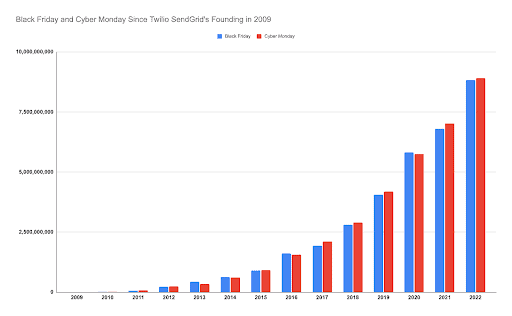ecommerce email senders: Are you ready for holiday and shopping online newsletter?
תוכן עניינים
E-commerce forums currently discussing email marketing expectations for the holiday season, including Black Friday and Cyber Monday.
Participants share best practices, ideas, coupons, automation charts, and campaign schedules. These all guarantee a successful holiday season email marketing campaign.
The holiday season is the peak sales period for retailers who spend months preparing for it. Email marketing, like fitness, needs consistent improvement for better competition results. Email marketers and retailers must prepare in advance to succeed in the competition for the inbox and recipients’ attention.
The number and frequency of emails during holidays and online shopping holidays continue to grow and break records yearly. Based on the emerging trend from previous years’ data, it is highly likely that it will break a record this year during holiday season shopping, such as Black Friday, Cyber Monday, etc.

What do e-commerce managers and retailers overlook?
Brands that prioritize immediate results are often disadvantaged regarding email marketing ROI. Email marketing has a broader potential beyond just the low-hanging fruits. Instead, email marketers should also invest efforts in lower-yield strategies. That quote is from my podcast interview with Chad S. White, head of research at Oracle marketing consulting and author of the best-selling book “Email Marketing Rules”.
What do brands really give to their customers?
Brands often use email marketing to send promotions, coupons, and marketing campaigns, but excessive frequency can lead to recipient disengagement and email fatigue.
According to Seth Godin, marketers must ask themselves if they will be missed once they’re gone. Do you know if your clients and recipients miss your emails?
Brands can benefit significantly from diversifying conversations beyond sales and consistently delivering desired content to consumers. A relationship with customers (like any relationship) requires maintenance, diversification, and breaking the routine. Brands should integrate content encourages them to engage in a dialogue beyond commercial topics. This also has advantages in terms of deliverability.
To be effective, marketers must consider both their own sales objectives and customer desires.
Everyone desires informative and entertaining content beyond mere promotions and offers in today’s digital shopping era. Brands can develop educational and entertaining content that customers eagerly expect.
Brands can produce captivating and valuable content (educational, entertaining, etc.) that customers eagerly expect.
In a podcast interview, Joe Pulizzi, a renowned expert in content marketing, bestselling author, and co-host of This Old Marketing podcast with Robert Rose, shared his insights.
האזנה לפודקאסט

פודקאסט ובלוג העוסקים בנושאי אימייל מרקטינג (email marketing), עבירות אימיילים (deliverability) ושיווק.
הגעתם אל הבלוג והפודקאסט המובילים והמעודכנים ביותר בעברית בנושא אימייל מרקטינג ועבירוּת אימיילים הכולל עשרות רבות של מאמרים מפורטים ופודקאסטים בנושא אימייל מרקטינג למתחילים ומתקדמים ומכסה את התחום בצורה מקצועית.
חלק מהפרקים הם ראיונות עם מומחי אימייל מרקטינג בינלאומיים מובילים.
אימייל מרקטינג הוא ערוץ ותיק, אבל אולי דווקא בגלל שהוא “הסבא” של המדיה הדיגיטלית הוא לא מקבל את תשומת הלב וההתמקצעות הראויה.
אבל זה הולך ונהיה קשה… כדי להצליח באימייל מרקטינג צריך להתמקצע ולא לסמוך רק על כך שהפלטפורמה (מערכת הדיוור) תעשה את הכל.
אפשר למצוא כאן עשרות מאמרים ופודקאסטים מקצועיים ומפורטים בנושא אימייל מרקטינג, עבירוּת אימיילים, סקירת מערכות דיוור, אוטומציה שיווקית, שיווק באמצעות תוכן, אימייל מרקטינג עבור איקומרס, טיפים לשיווק במייל ועוד.
A blog and a podcast (in Hebrew) about email marketing, email deliverability, marketing, and data.
Joe Pulizzi הוא “הכוהן הגדול” של שיווק מבוסס תוכן.
בזכותו המונח Content Marketing הפך למטבע לשון.
הוא מהמומחים המובילים בעולם לשיווק מבוסס תוכן ומייסדם של מספר סטארט-אפים ויזמויות בתחום התוכן, כולל אתר ליוצרי תוכן, The Tilt, אירוע ליזמים בתחום התוכן Creator Economy Expo (CEX).
הוא מחברם של שבעה רבי מכר כולל Content Inc. ו-Epic Content Marketing (שעומד לצאת ב-2023 בהוצאה מחודשת) וספרים נוספים.
הוא מגיש יחד עם Robert Rose את הפודקאסט This Old Marketing בכל יום שישי, ואת הפודקאסט Content Inc בכל יום שני ורביעי.
שוחחנו בין השאר, על השימוש המוצלח שעושים יוצרי תוכן באימייל לבניית קהילות, תוכניות נאמנות, שימוש במטבעות נאמנות (social tokens), הפצה ויראלית של תוכן באמצעות ניוזלטרים, החשיבות של minimum viable audience ועוד.
See omnystudio.com/listener for privacy information.

A Bermuda Triangle in Email Marketing
In the Atlantic Ocean lies the Bermuda Triangle, a region known for its inexplicable happenings, like the vanishing of aircraft and vessels.
Sometimes, as email marketers, we can’t help but feel that strange and mysterious events are taking place with our sent emails. We put a lot of effort into our campaign, but many recipients did not engage with it for some unknown reason.
Marketers often prioritize planning everything that revolves around the campaign during campaign preparation but overlook three small yet crucial elements.
In the Bermuda Triangle of email marketing, three key elements decide the fate of your emails. To ignore an email, one must pay attention, analyze its contents, and make a deliberate choice.
When deciding whether to open or ignore an email, people typically scan three things: the name of the sender (the friendly from), the subject line, and the pre-header (secondary subject line).
The sender’s name (Friendly From)
The repetition of the brand name in the recipient’s inbox forms a continuing brand impression, just like repeated exposure to TV ads or billboards.
People can choose not to open their emails, but the repetition serves as a reminder of the brand’s existence and enhances other campaigns, leading to increased exposure and brand awareness.
A video from the podcast interview with Dela Quist, Alchemy Worx’s advisor and founding partner, the world’s largest email marketing agency. Episodes 181 & 182.
האזנה לפודקאסט

פודקאסט ובלוג העוסקים בנושאי אימייל מרקטינג (email marketing), עבירות אימיילים (deliverability) ושיווק.
הגעתם אל הבלוג והפודקאסט המובילים והמעודכנים ביותר בעברית בנושא אימייל מרקטינג ועבירוּת אימיילים הכולל עשרות רבות של מאמרים מפורטים ופודקאסטים בנושא אימייל מרקטינג למתחילים ומתקדמים ומכסה את התחום בצורה מקצועית.
חלק מהפרקים הם ראיונות עם מומחי אימייל מרקטינג בינלאומיים מובילים.
אימייל מרקטינג הוא ערוץ ותיק, אבל אולי דווקא בגלל שהוא “הסבא” של המדיה הדיגיטלית הוא לא מקבל את תשומת הלב וההתמקצעות הראויה.
אבל זה הולך ונהיה קשה… כדי להצליח באימייל מרקטינג צריך להתמקצע ולא לסמוך רק על כך שהפלטפורמה (מערכת הדיוור) תעשה את הכל.
אפשר למצוא כאן עשרות מאמרים ופודקאסטים מקצועיים ומפורטים בנושא אימייל מרקטינג, עבירוּת אימיילים, סקירת מערכות דיוור, אוטומציה שיווקית, שיווק באמצעות תוכן, אימייל מרקטינג עבור איקומרס, טיפים לשיווק במייל ועוד.
A blog and a podcast (in Hebrew) about email marketing, email deliverability, marketing, and data.
ראיון לפודקאסט עם Dela Quist שותף מייסד ויועץ של Alchemy Worxs סוכנות האימייל מרקטינג הגדולה בעולם, מעל ל-100 עובדים ונוכחות בינלאומית בארבע יבשות.
את Dela אני מכיר מקהילת Only Influencer, קהילה בינ”ל של אנשי אימייל מרקטינג שבה אנו חברים.
במרוצת השנים הזדמן לנו להשתתף יחד בוובינרים ודיונים שונים.
הוא אחד האנשים החכמים בתעשייה (גם אמרתי לו את זה) ותמיד כייף ללמוד ממנו.
אם באימייל מרקטינג יש דברים שהשתרשו כ-best practice או כ”פרות קדושות” Dela “שוחט אותן” ותמיד זה מגובה בדאטה תומכת.
See omnystudio.com/listener for privacy information.

Subject Line (Headline)
Its header, sender’s name, and subtitle influences the email open (or ignored). But many marketers do not pay proper attention to crafting headlines. As a result, they often realize at the last moment, just before a campaign has to be sent, that a headline needs to be drafted, and then only invest a few moments in it. Many email marketers fall into the same pitfall of overlooking the “email Bermuda triangle.”
The title can be short, long, with or without emoji, but there’s a theory behind successful subjectlines that can increase open rates by 20%. The sender’s name (friendly from) and subject line, and the pre-header, have a synergistic relationship.
Pre-header (the second subjectline)
The subjectline and the address and sender’s name provide additional space to tell a complete story. The subjectline, sender’s address, and sender’s name (friendly from) are visible in the inbox before the email is opened. marketeer’s proper use of this triangle (from name, subjectline, pre-header) can influence the recipient’s behavior of opening or ignoring the email. For example, the pre-header can answer a question posed in the subjectline or serve as a teaser.
Here is a brief excerpt from the podcast with Jay Schwedelson, founder of Guru Events, the world’s largest online email marketing event. The full podcast with Jay is episode number 203
האזנה לפודקאסט
Deliverability = the foundation of every email program
Think of your email program as a building. The business must have deep deliverability foundations to handle increased email activity during the shopping holiday season to prevent collapse.
The holiday season is one of the most important for many businesses, so investing in offenses, just like preparing for a marathon, should start well in advance.
Despite not preparing beforehand or establishing a strong foundation of wrongdoing, there are steps to safely navigate holiday and shopping emails (without causing a disaster).
Send from your domain
Make sure that your email platform (ESP) uses your domain when sending emails rather than a shared domain of the ESP. In the vast majority of email marketing platforms, you can verify your domain. Setting up SPF and DKIM records in your domain’s DNS is a one-time action that will enable you to develop a unique reputation for your domain.
Since email has different roles in almost every business (one-to-one, marketing, operational, transactional), different considerations, such as the number of emails in each category, will determine whether it is advisable to separate different activities (email streams) into separate sub-domains and servers.
האזנה לפודקאסט

פודקאסט ובלוג העוסקים בנושאי אימייל מרקטינג (email marketing), עבירות אימיילים (deliverability) ושיווק.
הגעתם אל הבלוג והפודקאסט המובילים והמעודכנים ביותר בעברית בנושא אימייל מרקטינג ועבירוּת אימיילים הכולל עשרות רבות של מאמרים מפורטים ופודקאסטים בנושא אימייל מרקטינג למתחילים ומתקדמים ומכסה את התחום בצורה מקצועית.
חלק מהפרקים הם ראיונות עם מומחי אימייל מרקטינג בינלאומיים מובילים.
אימייל מרקטינג הוא ערוץ ותיק, אבל אולי דווקא בגלל שהוא “הסבא” של המדיה הדיגיטלית הוא לא מקבל את תשומת הלב וההתמקצעות הראויה.
אבל זה הולך ונהיה קשה… כדי להצליח באימייל מרקטינג צריך להתמקצע ולא לסמוך רק על כך שהפלטפורמה (מערכת הדיוור) תעשה את הכל.
אפשר למצוא כאן עשרות מאמרים ופודקאסטים מקצועיים ומפורטים בנושא אימייל מרקטינג, עבירוּת אימיילים, סקירת מערכות דיוור, אוטומציה שיווקית, שיווק באמצעות תוכן, אימייל מרקטינג עבור איקומרס, טיפים לשיווק במייל ועוד.
A blog and a podcast (in Hebrew) about email marketing, email deliverability, marketing, and data.

warming and rewarming your domain
After domain verification, the domain needs to be warmed up. This action aims to build a reputation for a new domain (or rewarming when switching between email platforms). Even if the domain or the IP is warm, when switching ESP, you require warming up your domain. Domain warm-up will take about a month, depending on your email frequency and volume. Sometimes, domain warmup can be shortened.
Certain email platforms can help warm up your domain by gradually splitting traffic with a shared domain until your domain is warmed. Typically, in ESPs, the domain workup is done manually in order to segment the data for a 30-day warm-up plan. The plan is to send more emails daily, starting with those recipients who show the highest engagement. The domain warm-up stage is vital as it determines the next steps: either continuing with a shared domain or switching to your own. It’s usually not recommended to do so right before the holiday season, since the warm-up duration is about 6-8 weeks.
Other than marketing emails, you need to consider other email activities, such as transactional or operational.
It’s important to be cautious when using external tools to heat the domain, as they can sometimes do more harm than good.
Cleaning your data before sending
During the holiday season, resist the temptation to email blast every list and unlock your full potential. It is better to email only to safe records. It’s a good idea to use reliable email verification services such as Bouncer, Zerobounce, Kickbox, or Webbula to prevent sending emails to invalid addresses, especially before a high volume, like during the holiday season. How do I know what safe addresses are? Those with a “valid” status are usually safe to send.
Avoid sending to a role-based and catch-all addresses. Here is a short excerpt from an interview I conducted with Izabala Harberchik of bouncer as part of the deliverability summit in Prague, June 2023.
Data segmentation
Many email marketeers just blast all recipients with the same email. The key to successful email marketing lies in segmenting data based on interests, products, and services. You can also use data to penalize subjectlines, not necessarily using the first name in the subsectline.
be aware of large spikes in volume
Mailbox providers like routine and don’t like to see large spikes in email volume. To send large quantities of emails on holidays, you should gradually increase the amount and prepare in advance, similar to warming up a domain.
Connect your domain to Google Postmaster Tools:
Google provides a free tool that gives an overview of deliverability metrics. To connect the domain to Google Postmaster Tools, a record needs to be established in the domain’s DNS. Google Postmaster tools give a snapshot of only the Gmail.com domain. While Google Postmaster Tools is useful, it can be problematic with data delays and slow issue resolution.
Monitoring hiden deliverability metrics inside your ESP
Mailing systems lack a dashboard to track deliverability status. Certain metrics in the mailing system are not visible, but they are valuable for safeguarding your deliverability. The metrics are:
הערכה ראשונית של מדדי עבירוּת
| Spam rate | Unsubscribe rate | Bounce rate | Unique click rate | Unique open rate | מקור |
| פחות מ-0.05% | פחות מ-0.2% | פחות מ-0.4% | מעל 2.5% | מעל 25% | מצוין |
| 0.05-0.08% | 0.2-0.3% | 0.4-0.8% | 1.5-2.5% | 15-25% | טוב |
| 0.08-0.15% | 0.3-0.7% | 0.8-1.5% | 1-1.5% | 10-15% | טעון שיפור |
| יותר מ-0.15% | יותר מ-0.7% | יותר מ-1.5% | פחות מ-1% | פחות מ-10% | גרוע |
Allow easy unsubscribe and use preference center
Make sure recipients have an easy and convenient option to remove themselves from emails. Starting 2024, easy unsubscribe will be mandatory on Yahoo and Gmail. We’d rather have people unsubscribe from emails than mark them as spam. Be sure to include a clear and visible unsubscribe link or button in the email template. If your email platform supports it, use the Preference Center that allows recipients to choose different content topics, change the frequency of emails, etc., instead of unsubscribing from the emails.
On the unsubscribe page, you can encourage recipients to resubscribe, to change their preference, to connect with you on social networks, listen to your podcast, or subscribe to your YouTube channel.
Why invest in deliverability?
It is essential to invest in deliverability proactively and continuously as the fight for inbox placement intensifies.
Here’s a short excerpt from the podcast with Adrian Williams, a friend, and a deliverability fellow. The full episode with Adrian is episode number 197.
האזנה לפודקאסט

פודקאסט ובלוג העוסקים בנושאי אימייל מרקטינג (email marketing), עבירות אימיילים (deliverability) ושיווק.
הגעתם אל הבלוג והפודקאסט המובילים והמעודכנים ביותר בעברית בנושא אימייל מרקטינג ועבירוּת אימיילים הכולל עשרות רבות של מאמרים מפורטים ופודקאסטים בנושא אימייל מרקטינג למתחילים ומתקדמים ומכסה את התחום בצורה מקצועית.
חלק מהפרקים הם ראיונות עם מומחי אימייל מרקטינג בינלאומיים מובילים.
אימייל מרקטינג הוא ערוץ ותיק, אבל אולי דווקא בגלל שהוא “הסבא” של המדיה הדיגיטלית הוא לא מקבל את תשומת הלב וההתמקצעות הראויה.
אבל זה הולך ונהיה קשה… כדי להצליח באימייל מרקטינג צריך להתמקצע ולא לסמוך רק על כך שהפלטפורמה (מערכת הדיוור) תעשה את הכל.
אפשר למצוא כאן עשרות מאמרים ופודקאסטים מקצועיים ומפורטים בנושא אימייל מרקטינג, עבירוּת אימיילים, סקירת מערכות דיוור, אוטומציה שיווקית, שיווק באמצעות תוכן, אימייל מרקטינג עבור איקומרס, טיפים לשיווק במייל ועוד.
A blog and a podcast (in Hebrew) about email marketing, email deliverability, marketing, and data.
See omnystudio.com/listener for privacy information.

רוצה להתייעץ איתי לגבי שיפור האימייל מרקטינג או עבירוּת המיילים שלך? אני מזמין אותך לפגישת ייעוץ ראשונית של 1/2 שעה, ללא עלות. book a 1/2 email deliverability discovery call.
Podcast interviews with international email marketing experts
האזנה לפודקאסט
Further reading
Sign up for Guru Conference

Sella Yoffe
Email Deliverability & Email Marketing Expert
working with global email senders, startups, and ESPs to improve their deliverability and email authentication
Podcast host & Blogger @ CRM.BUZZ & EmailGeeks.Show





